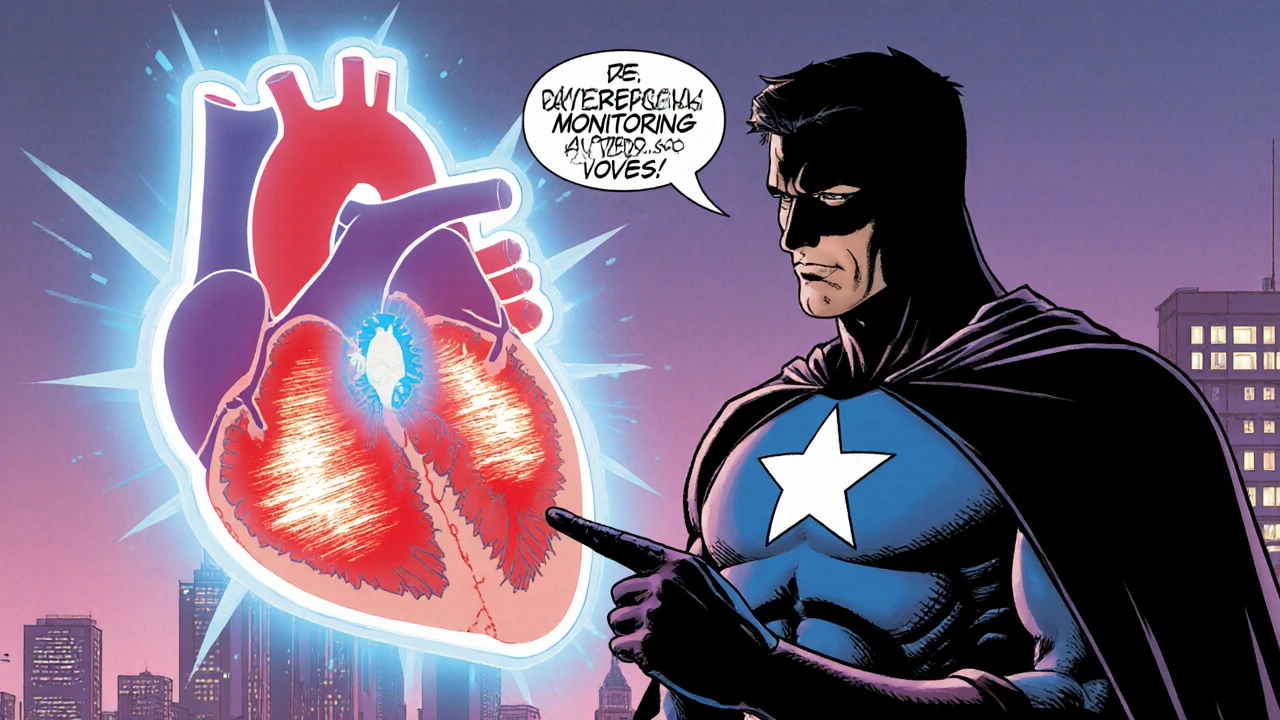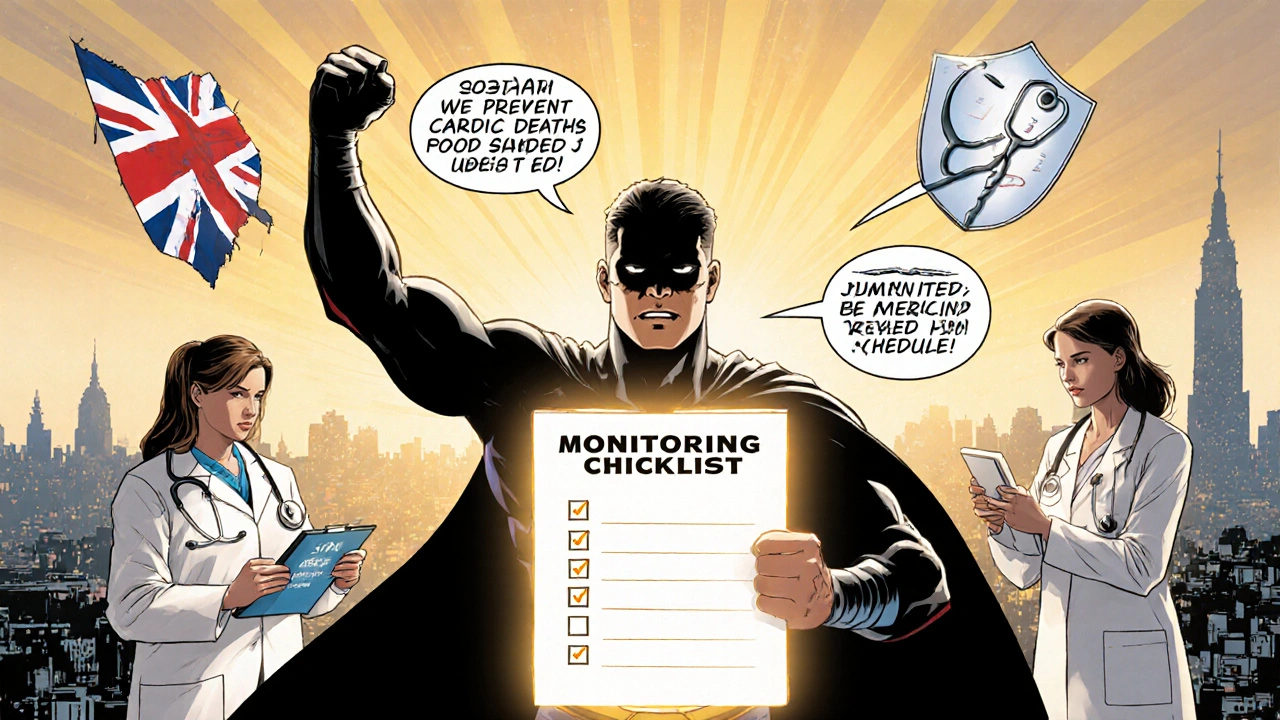
HSS Monitoring Schedule Calculator
Personalize Your Monitoring Schedule
This tool estimates your optimal monitoring frequency based on your specific condition parameters. Enter your current values to get a personalized recommendation.
When you hear Hypertrophic Subaortic Stenosis is a form of hypertrophic cardiomyopathy where the heart muscle thickens near the aortic valve, creating an obstruction to blood flow, the first thought might be about surgery or medication. But the real game‑changer is regular monitoring. Keeping tabs on the heart’s structure and function lets patients and doctors spot trouble early, tweak treatment, and dramatically cut the risk of life‑threatening events.
Key Takeaways
- Hypertrophic Subaortic Stenosis (HSS) can progress silently; routine imaging catches changes before symptoms worsen.
- Echocardiograms and cardiac MRIs are the gold‑standard tools for tracking wall thickness and outflow‑tract gradients.
- Holter monitors and exercise stress tests uncover hidden arrhythmias that may lead to sudden cardiac death.
- A personalized monitoring calendar-usually every 6‑12 months-balances thoroughness with patient convenience.
- Lifestyle logs, genetic testing, and clear communication with your heart team empower proactive risk management.
Understanding Hypertrophic Subaortic Stenosis
HSS belongs to the broader family of hypertrophic cardiomyopathy (HCM). The thickened septum squeezes the left ventricular outflow tract, raising the pressure the heart must generate to push blood into the aorta. Typical signs include chest pain, shortness of breath, fainting spells, and a harsh systolic murmur heard with a stethoscope.
Because the condition is often inherited, first‑degree relatives may need genetic testing to identify pathogenic sarcomere gene mutations. Knowing the genetic backdrop helps doctors anticipate disease course and tailor monitoring frequency.
Why Monitoring Is Critical
HSS doesn’t always announce itself with dramatic symptoms. The obstruction can creep upward over months or years. If unchecked, the pressure overload may trigger:
- Progressive dyspnea and exercise intolerance.
- Development of atrial fibrillation or ventricular tachycardia.
- Increased risk of sudden cardiac death especially in young athletes.
Early detection through scheduled tests lets clinicians prescribe beta‑blockers, adjust activity recommendations, or intervene surgically before complications become irreversible.

Core Monitoring Tools
Four modalities dominate HSS surveillance. Each offers a unique window into heart health, and most patients benefit from a combination.
| Tool | What It Measures | Frequency Typical | Key Advantage | Limitation |
|---|---|---|---|---|
| Echocardiogram | Septal thickness, outflow‑tract gradient, valve function | Every 6-12 months | Non‑invasive, bedside, inexpensive | Image quality can vary with body habitus |
| Cardiac MRI | Precise muscle mass, fibrosis detection, 3‑D geometry | Every 1-2 years or when echo changes | Gold standard for tissue characterization | Higher cost, requires breath‑holds |
| Holter Monitor | 24‑48hr rhythm, ectopic beats, heart‑rate variability | Annually or after symptom change | Catches intermittent arrhythmias missed on office ECG | Patient compliance; limited to short window |
| Exercise Stress Test | Functional capacity, blood‑pressure response, provoked gradients | Every 1-2 years | Reveals dynamic obstruction under stress | Not suitable for severe symptoms or high arrhythmia risk |
Most cardiology centers combine an echo with a yearly Holter. If the echo shows a sudden jump in septal thickness (≥2mm) or a pressure gradient climbs above 30mmHg, a cardiac MRI is ordered to assess scar tissue and decide whether surgical myectomy the removal of part of the thickened septum or alcohol septal ablation injecting alcohol to shrink the obstructive tissue might be indicated.
Recommended Monitoring Schedule
- Baseline Evaluation: Full echo, ECG, and genetic testing at diagnosis.
- Every 6Months: Repeat echo if gradient >30mmHg or symptoms evolve.
- Annual: 24‑hour Holter and symptom log review.
- Every 1-2Years: Cardiac MRI to detect fibrosis or disease acceleration.
- Every 2-3Years: Exercise stress test, provided the patient can safely exercise.
- Whenever New Symptoms Appear: Immediate office ECG and possible urgent echo.
Patients on beta‑blockers medication that reduces heart‑rate and outflow‑tract gradients may need tighter intervals, especially if dosage changes.
Lifestyle & Symptom Tracking Tips
Technology makes self‑monitoring easier than ever. A simple notebook or a phone app can capture:
- Exercise duration and perceived exertion (Borg scale).
- Any palpitations, light‑headedness, or chest discomfort.
- Blood‑pressure readings taken at rest and after activity.
- Medications taken, missed doses, and side‑effects.
Sharing this log before each appointment lets the heart team spot trends that a single office visit may miss.

Common Pitfalls & How to Avoid Them
- Skipping Appointments: Missing an echo can allow a steep rise in gradient that would have been caught early.
- Relying Solely on Symptoms: Many patients feel fine while the obstruction worsens silently.
- Ignoring Arrhythmia Screening: Even a brief run of ventricular tachycardia ups sudden‑death risk dramatically.
- Over‑restricting Activity: Too much limitation can reduce fitness, making breathlessness appear sooner. Balance is key.
Quick Monitoring Checklist
- Echo every 6months (or sooner if symptoms change).
- 24‑hr Holter once a year.
- Cardiac MRI every 1-2years.
- Exercise stress test every 2years if cleared.
- Update symptom log weekly.
- Review medication adherence each visit.
- Discuss family screening and genetic results.
Frequently Asked Questions
How often should I get an echocardiogram if my disease is stable?
When the outflow‑tract gradient stays below 30mmHg and you have no new symptoms, an echo every 12 months is typically enough. Your cardiologist may stretch it to 18 months if previous scans have been unchanged for several years.
Can lifestyle changes replace medication?
Exercise, weight control, and avoiding dehydration improve comfort, but they don’t reverse the thickened septum. Most patients still need a beta‑blocker or calcium‑channel blocker to keep the gradient low.
What signs mean I should call my doctor right away?
Sudden fainting, chest pain lasting more than a minute, rapid palpitations, or a new shortness of breath at rest are red flags. Get an urgent echo or ECG.
Is an implantable cardioverter‑defibrillator (ICD) ever needed?
If you develop sustained ventricular tachycardia, have a family history of sudden death, or show extensive fibrosis on MRI, an ICD may be recommended to stop a lethal rhythm.
Do children with HSS need the same monitoring?
Kids are usually screened every 12 months with echo and ECG. Because growth can alter wall thickness, tighter follow‑up is common, especially if they play competitive sports.
Ragha Vema
August 29, 2025 AT 12:31Regular monitoring is the hidden safety net that keeps the silent killer at bay; without it, the disease can creep up like a thief in the night. Think of every echo and Holter as a checkpoint on a marathon, alerting you before the body hits the wall. It’s not just about catching a gradient rise; it’s about preserving the moments you love with family and friends.
Scott Mcquain
August 29, 2025 AT 12:33It is our moral duty, dear community, to insist on consistent follow‑ups; skipping an appointment is tantamount to neglecting one’s own health, and neglect, in turn, breeds regret. Every six months, the echo should be scheduled, no excuses; the heart deserves that vigilance.
kuldeep singh sandhu
August 29, 2025 AT 12:35While many proclaim that yearly scans suffice, I maintain that a one‑size‑fits‑all approach ignores individual variability; nonetheless, occasional over‑monitoring can cause unnecessary anxiety.
Zac James
August 29, 2025 AT 12:36From a broader health‑care perspective, integrating patient‑reported symptom logs with imaging results creates a richer picture; many clinics are now adopting digital apps to streamline this process, benefitting both patients and providers.
Arthur Verdier
August 29, 2025 AT 12:38Oh, you think a single echo every twelve months is enough? That’s adorable. The data clearly shows that gradients can jump 10‑15 mmHg in a matter of weeks, and those who ignore the red flags are practically inviting disaster.
Breanna Mitchell
August 29, 2025 AT 12:40Let’s keep the momentum going! Staying on top of your monitoring schedule not only catches issues early but also empowers you to make informed lifestyle choices that boost overall wellbeing.
Alice Witland
August 29, 2025 AT 12:41Sure, because spending extra time on a cardiac MRI is everyone's favorite pastime, right? In reality, the detailed tissue characterization can be a game‑changer for deciding if an intervention is truly necessary.
Chris Wiseman
August 29, 2025 AT 12:43When we contemplate the labyrinthine corridors of cardiac physiology, we are reminded that the heart does not operate in isolation but rather performs a symphony of mechanical and electrical harmonies; each echo, each Holter, each MRI, contributes a distinct instrument to this orchestral composition. The echo, with its real‑time Doppler whispers, narrates the tale of septal thickness and pressure gradients, offering the clinician a snapshot of the current state of obstruction. Yet, one must not be deceived by the allure of brevity, for the static image can veil the subtle evolution of fibrosis that only cardiac MRI, with its exquisite contrast resolution, can unveil. In the same vein, the Holter monitor, though seemingly modest in its 24‑hour vigil, can intercept fleeting arrhythmic murmurs that would otherwise elude standard ECG. Imagine a scenario where the gradient hovers just below the intervention threshold, but the tissue scar burden climbs inexorably; a timely MRI could tip the scales toward prophylactic septal reduction. Moreover, the exercise stress test, often underappreciated, challenges the heart under physiologic load, revealing dynamic obstruction that rests dormant at rest. The confluence of these modalities, when judiciously sequenced, crafts a narrative that is greater than the sum of its parts. It is this narrative that guides us in tailoring beta‑blocker dosages, timing surgical considerations, and counseling patients on activity modifications. Neglecting any single chapter of this story risks writing a tragic ending that could have been averted. Hence, the mantra of regular monitoring should not be a rote schedule but a personalized chronicle, responsive to each patient’s genetic backdrop, symptom trajectory, and life aspirations. By embracing this holistic approach, we honor not only the anatomical intricacies of hypertrophic subaortic stenosis but also the human experience of living with it. In short, continuous surveillance is the compass that steers us away from the perilous reefs of sudden cardiac death. Let us, therefore, champion a proactive stance, for in the realm of cardiology, foresight is the most potent therapy.
alan garcia petra
August 29, 2025 AT 12:45Stick to the schedule, log your symptoms, and you’ll be ahead of any nasty surprises.
Allan Jovero
August 29, 2025 AT 12:46Adherence to the recommended monitoring interval is essential for optimal patient outcomes.
Andy V
August 29, 2025 AT 12:48It is imperative that the phrasing “every 6‑12 months” be standardized across all clinical guidelines; inconsistencies only breed confusion among practitioners.